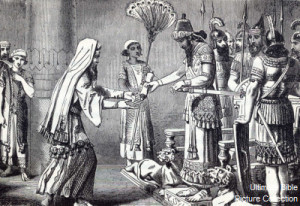Excerpted from Ancient Israel From Abraham to the Roman Destruction of the Temple. Ed. Hershal Shanks. Washington, D.C.- Biblical Archaeology Society, 1999.
Samaritans
Unfortunately, Judah’s Samaritan neighbors sought to influence the Persians to limit the development of the renascent Jewish community. Initially, “the adversaries of Judah and Benjamin” (that is, the rulers of Samaria) offered to assist Zerubbabel in rebuilding the Temple of Yahweh, claiming that they too were worshipers of the Hebrew God and had been since they were settled in the land by the Assyrians. Zerubbabel rebuffed the Samaritans’ proffered assistance, however, and this led to their harassing the returning Judahites through correspondence with Persian officials (Ezra 5-1–6-18). 37
The Yahwistic inhabitants of what was formerly Israel, whose help Zerubbabel rejected, were descendants of Syrian-Mesopotamians. After the Assyrians destroyed the northern kingdom in 722 B.C.E., they sent colonists to settle the district. These Syrian- Mesopotamian colonists subsequently adopted the religion of the land (2 Kings 17-24–41 ). The biblical writers explain the hostility of the Samaritans, as these people came to be known, as resulting from the petty jealousy of a people whose mixed ethnic background and syncretistic Yahwism precluded participation in a renewed Jewish cult. It is not difficult to see the political agenda, however, in strained relations between the peoples of these two regions. We are told that the “people of the land discouraged the people of Judah” throughout the reign of Cyrus (that is, from 539 to 530 B.C.E.) to the time of Darius I, during the reign of Ahasuerus (Xerxes, 486–465 B.C.E.), and in the days of Artaxerxes I (465–424 B.C.E.;Ezra 4-4–23).
Despite the opposition of the Samaritans, the appointment of a Davidic scion (Zerubbabel), who was raised in Babylonia, with the support and full knowledge of the Achaemenid leadership was a stroke of political genius. It was also consistent with Persia’s overall policy of installing loyal representatives of the conquered indigenous populations who could prevent insurrection and foster loyalty to the imperial throne. 38 Pairing the Davidic Zerubbabel with Joshua, the son of Jehozadak, as high priest was a move meant to assuage local concerns and give the newly established subprovince of Yehud (Judah) maximum freedom in invigorating its historic religion while limiting autonomy on the political level. The relative success of such an approach is best observed through the absence of organized opposition to Persia for at least two generations or more. The negative aspect of this was the apparent increase in the appeal of non-Yahwist religious practices in the time of Ezra and Nehemiah. Nonetheless, recent scholarship has attributed to the Persian period an unprecedented flurry of literary activity that surely
found its support and inspiration in the reestablished Jewish community of Palestine. 39
